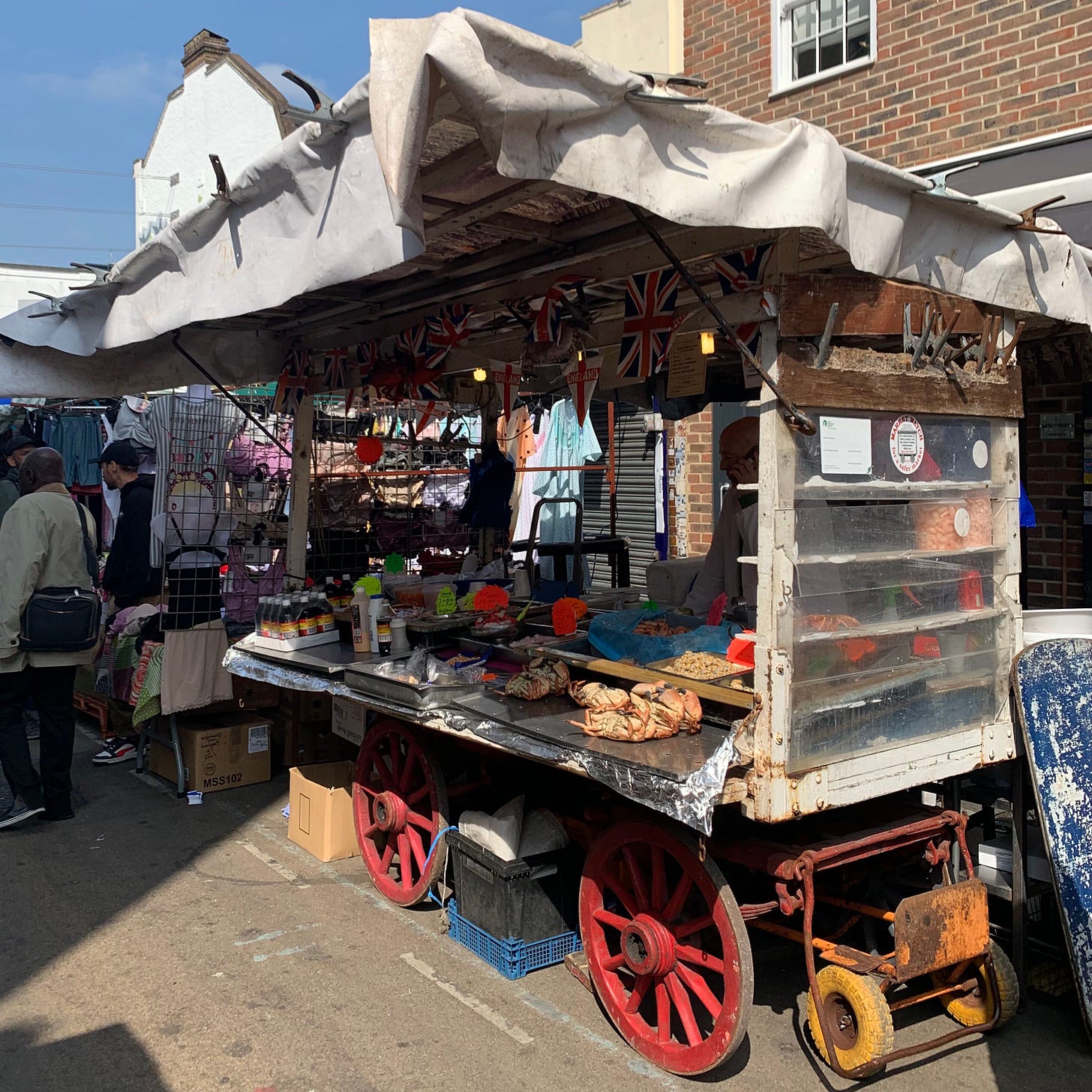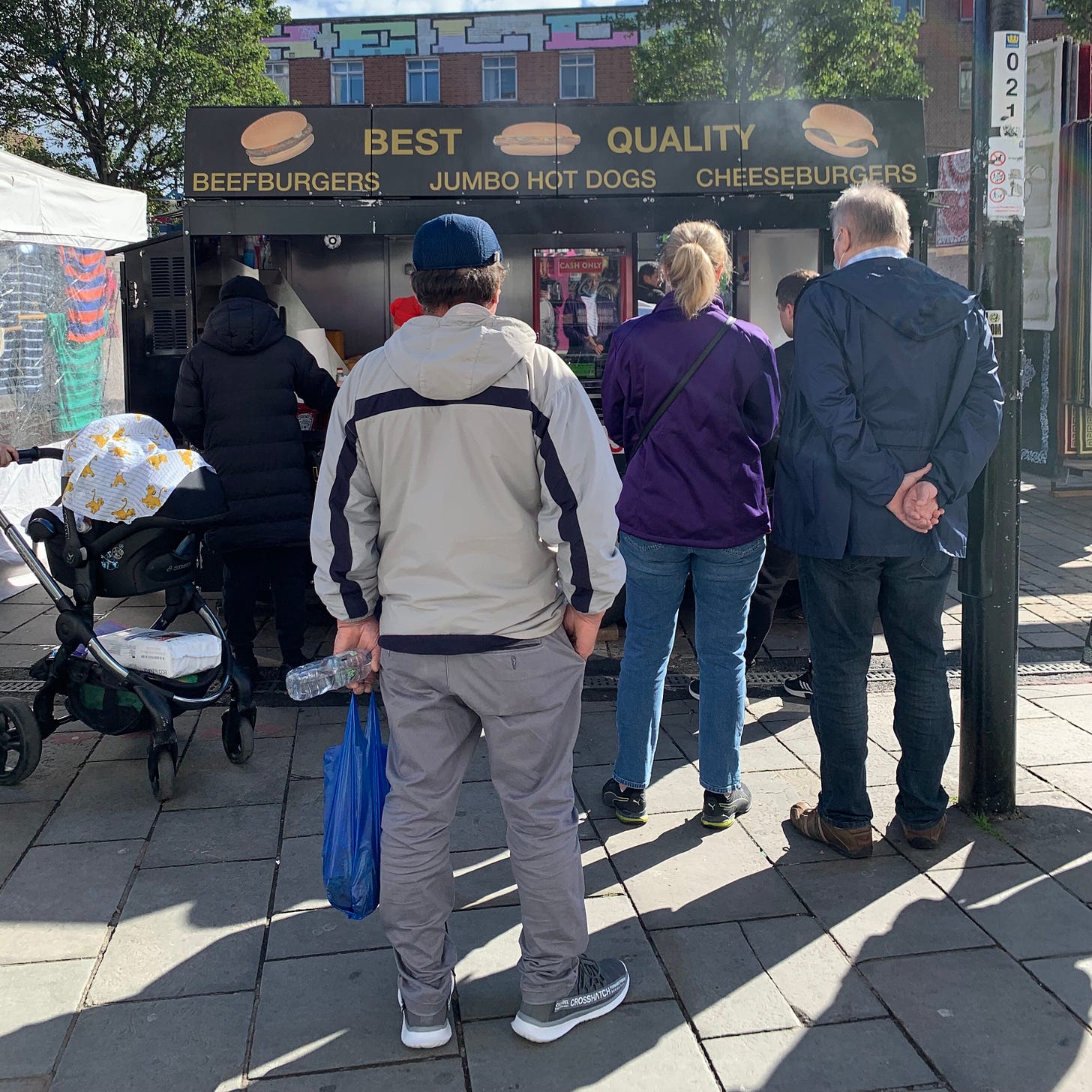Hello and welcome to Wooden City, a newsletter about London.
If you haven’t come here via @caffs_not_cafes, I'm a writer called Isaac Rangaswami and this is my Substack.
Every other week I publish an article about everyday places in London with unusual staying power, like shops, buildings, restaurants and public spaces.
In case you missed it, here’s my second-hand bookshops guide from earlier this month.
With its evocative red wagon wheels, the seafood stall on East Street Market in Walworth was one of the first places that made me consider the history of London food. Before that I’d only ever had cockles on the coast, and I loved seeing people eating them in such an urban area, just a few miles from Oxford Street. When I tried to understand why, I learned this stall was part of a dying tradition, tied up with the city’s history of eating food outside, often from elsewhere.
Some of the regulars who come to East Street for prawns, fish sticks and bouncy little bivalves may remember Walworth’s cockney past, along with the sarsaparilla seller that used to be here too. They are also probably why this seafood stand still exists: it has no Google Maps listing, and lives exclusively within the market on Saturdays. The man who’s run it all these years comes back because of the footfall that springs up around his stall each week, and those who expect him to be there.
We have markets to thank for other London food anachronisms, such as Ivy’s in Poplar and Randolfi’s in Bow, tethered as they are to Chrisp Street and Roman Road. If they’d traded closer to London’s centre, these fragments of the old East End may have vanished years ago. Instead they persist in areas with more captive audiences and comparatively fewer chains, which remain distinctive despite being less set apart than they once were. These businesses weave themselves into the routines of those who work and shop near them, just as their customers weave themselves into these places in return.
I’m fascinated by the role markets have in this phenomenon: by creating a kind of high street within a high street, where activity spikes on market days and an area’s local character shifts in a rhythmic way. Market traders and satellite businesses benefit from the concentration of demand created by these rhythms, but they reinforce their own position too. With those that cook food, they do this by solving a critical problem: what to eat during a visit to the market.
As well as safeguarding spots that perish elsewhere, I think markets breed special types of eating places more generally. While these places are functional, in that they often sell food that is hand-held, they also offer moments of pleasure. As localness becomes rarer, I think this is how they've stayed commercially sustainable. To test this idea further, I’ve been going back to four distinctive London markets, each of which has a food business with few equivalents across the city. As part of this, I’ve tried to paint a standalone portrait of each place and the market in which it lives.
Burger stall – Lewisham Market
Lewisham High Street looks naked in the evening when the stalls are closed and the shoppers have been replaced by seagulls and wooden pallets. There’s been a market around here for 118 years, but there are few clues to that history, other than perhaps the broadness of the road. It’s just a normal town centre really, where on the street you can also buy things like fish, vegetables and duvet covers during the day.
I go on Sundays, when the burger stand’s there. It’s at Deptford on Saturdays too and at peak times, the queue can be 10 people deep. The guy who runs the stall has slicked-back hair and a constant look of concentration on his face, because he has so many competing priorities to deal with: taking orders, accepting payments, flipping the burgers, tending to the ribbons of onion wilting on his grill. He’s too busy to chat, but greets the customers he knows by name.
I’m interested in his burgers because they fit within Britain’s more straightforward burger tradition. Even though he’s started using brioche buns lately, and meltier cheese, they remain closer to what you’d get at a Wimpy or a funfair. In London, these burgers are the preserve of kebab shops, as well as the burger vans that appear outside industrial parks, football stadiums and the odd public space, such as this stall in Lewisham and Jake’s on Putney Heath.
I used to get the single cheeseburger, but now I have a double, because there’s more to bite through and two patties means more cheese. I still get it with onions but I’ve recently changed from burger sauce to ketchup, because it’s so mellow anyway and you need the bright red to cut through. I have some photos of the stall from 2021 and I can see its prices have risen by 50p since then, a slow rate of inflation when compared to the retailers that surround it.
I love the burger here, but eating it can be a dangerous game. Once when I was taking a bite, the styrofoam container on my lap blew away just as some sauce dripped out, clearing the path to my jeans. This happened on a bench in the middle of the high street, where I always eat. The mountain of containers in the bin makes me think many others do the same.
Lewisham High St, Lewisham SE3




